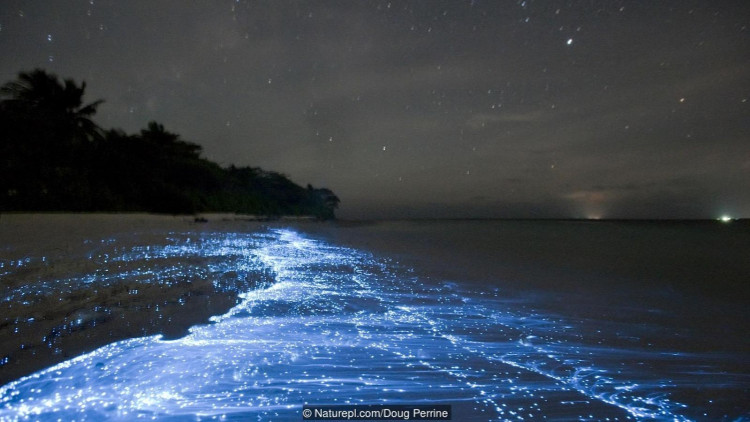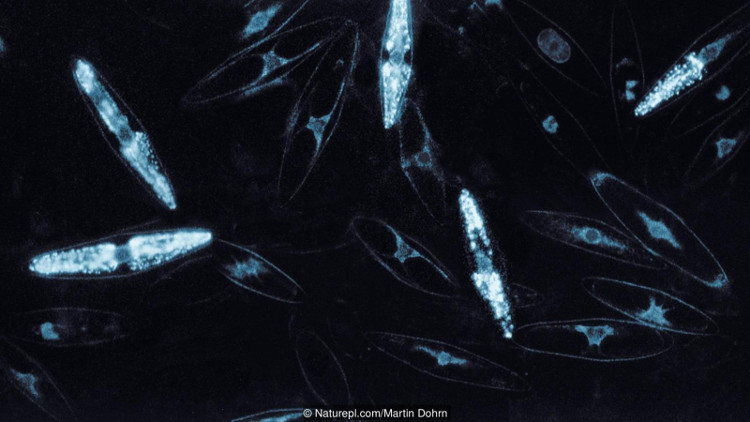The ocean will become a strange world every night
The mysterious ocean, combined with dark night, made it mysterious.
Blue light waves, synchronized breeding corals, directional positioning with stars etc. are strange phenomena that can only be witnessed after dark.
1. The shimmering waters
Probably not less than once, did you see glowing sea pictures, like the image below?

The beach glows.
That light is a bioluminescence phenomenon, caused by a kind of plankton called dinoflagellates (also called fried algae) . It usually happens when night falls in some seas or oceans, characterized by waves of sparkling light like electric lights.
But frying algae glows when there is impact, and that's why they are seen sparkling on the waves. Sometimes, you will see the water around the boat's body, the oars shine, even using your hands to surf on the water to see - it is because of the fried algae.
These tiny organisms are the most common sources of bioluminescent on the ocean surface. Sometimes the population of fry algae increases too quickly, causing algal blooms, also known as red tides due to red or brown colors.

Song fried algae.
Bioluminescence has been recorded in many oceans around the world, but Puuerto Rico and Jamica are the two most famous places, because this phenomenon occurs quite often and in very long time.
In addition, there is a more strange and rare phenomenon called Milky sea - the phenomenon of continuous and continuous flow of water like the galaxy. Only one case was recorded in 1915, when Milky sea appeared on the Indian Ocean, near Java Island, Indonesia.
Milky sea is not produced by the fry of algae, but is due to a huge number of fluorescent bacteria accumulated over long periods of time on the ocean surface.
2. And the animals are as bright as the moon in the ocean
Not only are the algae fried, but bioluminescence also occurs in many other animals, such as fish, squid and some mollusks. Amidst the deep and dark seas, they shine brightly like the moon, beautiful and extremely attractive.

A squid species capable of luminescence.
Camouflage, defending and attracting prey are the reasons they are forced to shine.

In deep waters, most living organisms have the ability to luminescence to create light sources.
Professor Matt David, professor of Biology at St. University Cloud State (USA) said: "The fish that glows often wrap a bag under the eyes, the inside contains fluorescent bacteria to create light. At night, they will use this light to find food and communication ".
In deep waters, most living organisms have the ability to luminescence to create light sources. In shallow seas, only a few have that ability.
3. Moonlight creates the biggest "lovemaking" party in the ocean
On a bright moonlit night of the spring, there will be more than 130 coral species simultaneously releasing eggs and sperm into the water for about 30-60 minutes. This reproductive event may be the best example of synchronized behavior in the natural world.
When egg cells and sperm are released, they move at the same time to shape the coral, before dispersing when the sperm fertilizes.

When egg cells and sperm are released.
Dr. Oren Levy, an ecologist at Bar-Ilan University, Iselel said that this is an amazing phenomenon. He explained that moon light acted like an alarm clock. It combines with some other signals from the environment such as when the sun sets, the water temperature, the tide time . The coral receives those signals in order to achieve optimal efficiency in reproduction.
4. Moonlight is a dangerous signal
A study in 2016 suggested that a seal when swimming at night a full moon is at risk of being eaten by sharks. The reason is because moonlight shines on the surface of the sea, making it easy for predators to hide below.
But that is not true. Other studies have shown that most of the shark attack cases occur after the sunrise. But at dawn, when the moonlight was not completely gone, seals were safer. This phenomenon is as true if it is a full moon night.
The reason given is what moonlight combined with dawn can reduce shark's camouflage ability, and then the advantage belongs to seals.
In addition, seals rely on another natural trait to determine the direction - the stars. In an experiment using a simulated night sky, seals tend to swim towards the brightest star. In nature, the sea bridge is based on the position of the stars to find their way back to the mainland.
5. "Monsters" creatures emerge every night
Due to the darkness, it is difficult to see animals floating to the ocean surface to search for food at night. However, the phenomenon of marine animals swim to the surface at dusk and disappear at dawn very popular.
For example, Humboldt squid is one of the species that regularly floats to the surface of the sea at night to find food. In the daytime, they hide under deep water in the Eastern Pacific, and by the night swim to the surface to find food.

Humboldt squid is also called "red devil".
Being able to change color and turn bright red when agitated, Humboldt squid is also called "red devil". They use powerful tentacles to capture and tear their prey. Sometimes they also attack people.
However, even when aggressive, they can become prey to larger predators such as swordfish or sharks.
Explaining the phenomenon of night hunting by some species, Professor Rodhouse said: "The reason they work at night is to avoid becoming the prey of the top predators."
- Detecting strange fields in the deep sea
- What do you know about Black Night: The mysterious
- Detecting strange footprints near the ocean surface nearly 4km
- The world has the fifth undiscovered ocean
- Strange feeling in the dark night at the museum
- 'Ghosts' in the world's deepest ocean trench
- Discover 4 strange sea creatures with human-like teeth
- Shivering before strange statues in the heart of the ocean
- This is the answer to why you always find it difficult to sleep when you put your back in a strange place
- See the Earth as beautiful as Van Gogh
- Strange rainbow in the night
- NASA decided to decipher the mystery of the ocean
 Surprised: Fish that live in the dark ocean still see colors
Surprised: Fish that live in the dark ocean still see colors Japan suddenly caught the creature that caused the earthquake in the legend
Japan suddenly caught the creature that caused the earthquake in the legend A series of gray whale carcasses washed ashore on California's coast
A series of gray whale carcasses washed ashore on California's coast Compare the size of shark species in the world
Compare the size of shark species in the world Admire 7 planets in the Solar System appearing at the same time in the night sky
Admire 7 planets in the Solar System appearing at the same time in the night sky  Top 5 extremely common habits before bed, seemingly normal but have unexpected harmful effects
Top 5 extremely common habits before bed, seemingly normal but have unexpected harmful effects  Why is it cold when the forecast is cold but it doesn't feel cold?
Why is it cold when the forecast is cold but it doesn't feel cold?  The human mind is not designed to stay awake past midnight.
The human mind is not designed to stay awake past midnight.  Flock of 50 rare and mysterious parrots discovered in Australia
Flock of 50 rare and mysterious parrots discovered in Australia  Is Night Shift yellow screen mode on phones really effective?
Is Night Shift yellow screen mode on phones really effective? 